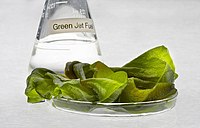
Photo from wikipedia
Conversion of Gracilaria gracilis (G. gracilis) into bio-products was carried out via pyrolysis at different temperatures to determine its potential for phenol-rich bio-oil. Co-Mo supported on zeolites (HZSM-5), mesoporous (HMS)… Click to show full abstract
Conversion of Gracilaria gracilis (G. gracilis) into bio-products was carried out via pyrolysis at different temperatures to determine its potential for phenol-rich bio-oil. Co-Mo supported on zeolites (HZSM-5), mesoporous (HMS) catalysts and their composites (ZH) were investigated and compared to each other on catalytic pyrolysis processes. In non-catalytic tests, the maximum weight percentage of bio-oil was 42wt% at 500°C and had the maximum amount of phenol (6.28wt%). in the catalytic tests by ZH composites; the addition of zeolite content in the structure of composites significantly decreased total concentrations of acetic acid and formic acid from 9.56 to 8.12wt% and slightly decreased phenol and furfural concentrations from 6.65 and 6.98 to 5.88 and 5.49wt%, respectively. Furthermore, the best selectivity for hydrogen yield (6.08mmol/g macroalgae) and lowest amount of acetic acid (5.4wt%) was observed for CoMo/ZH-20 catalyst, that is synthesized by 20wt% of zeolite.
Journal Title: Bioresource technology
Year Published: 2017
Link to full text (if available)
Share on Social Media: Sign Up to like & get
recommendations!